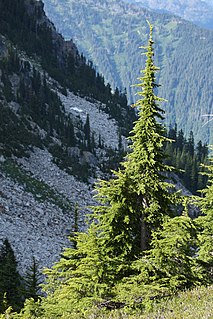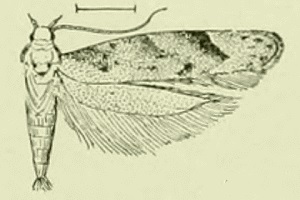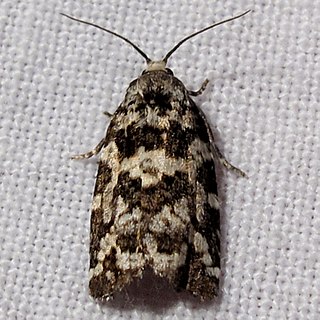
Tsuga canadensis, also known as eastern hemlock, eastern hemlock-spruce, or Canadian hemlock, and in the French-speaking regions of Canada as pruche du Canada, is a coniferous tree native to eastern North America. It is the state tree of Pennsylvania. Eastern hemlocks are widespread throughout much of the Great Lakes region, the Appalachian Mountains, the Northeastern United States, and Maritime Canada. They have been introduced in the United Kingdom and mainland Europe, where they are used as ornamental trees.

Tsuga mertensiana, known as mountain hemlock, is a species of hemlock native to the west coast of North America, found between Southcentral Alaska and south-central California.

The brown-tail moth is a moth of the family Erebidae. It is native to Europe, neighboring countries in Asia, and the north coast of Africa. Descriptions of outbreaks, i.e., large population increases of several years duration, have been reported as far back as the 1500s. The life cycle of the moth is atypical, in that it spends approximately nine months as larvae (caterpillars), leaving about one month each for pupae, imagos and eggs. Larvae (caterpillars) are covered in hairs. Two red spots on the back, toward the tail, distinguish these species from other similarly hairy moth larvae. The winged adults have white wings and a hairy white body with a tuft of brown hair at the tip of the abdomen. Females lay one egg cluster, usually on the underside of a leaf of a host plant. The species is polyphagous, meaning that it feeds on many different species of trees, including pear, apple, maple and oak.

The light brown apple moth is a leafroller moth belonging to the lepidopteran family Tortricidae.

The hemlock woolly adelgid, or HWA, is an insect of the order Hemiptera native to East Asia. It feeds by sucking sap from hemlock and spruce trees. In its native range, HWA is not a serious pest because populations are managed by natural predators and parasitoids and by host resistance. In eastern North America it is a destructive pest that threatens the eastern hemlock and the Carolina hemlock. HWA is also found in western North America, where it has likely been present for thousands of years. In western North America, it primarily attacks western hemlock Tsuga heterophylla and has only caused minor damage due to natural predators and host resistance. Accidentally introduced to North America from Japan, HWA was first found in the eastern United States near Richmond, Virginia, in 1951. The pest is now found from northern Georgia to coastal Maine and southwestern Nova Scotia. As of 2015, 90% of the geographic range of eastern hemlock in North America has been affected by HWA.

The hemlock moth, also known as the defoliating hemlock moth or poison hemlock moth, is a nocturnal moth species of the family Depressariidae. Of Palaearctic origin, it was first found in North America in 1973 when it was accidentally introduced. The moth is now widespread throughout the northern half of the United States, southern Canada, northern Europe, and, more recently, New Zealand and Australia. The larval form grows to around 10 mm, while the adults wingspan is between 17 mm and 19 mm.

The March dagger moth is a moth of the subfamily Chimabachinae. It is found in Europe and was first described by Michael Denis & Ignaz Schiffermüller in 1775.
Argyresthia canadensis, the Canadian arborvitae leafminer or cedar leafminer, is a moth of the family Yponomeutidae. It is found in North America.

Batrachedra praeangusta is a moth of the family Batrachedridae which is native to Europe. It is also found in North America. It was first described by Adrian Haworth in 1828 from the type specimen found in England. The foodplants of the larvae are poplars and willows.

Acleris semipurpurana is a species in the moth family Tortricidae, and one of several species of moth commonly known as oak leaftier or oak leaf tier. The larvae feed on the leaves of oak trees in the Eastern United States and southeastern Canada which can be a major cause of defoliation. The loss of leaves can kill or damage the affected trees, which are chiefly in the Lobatae or red oak section of Quercus, or oaks.

Archips semiferanus is a species of moth in the family Tortricidae, and one of several species of moth commonly known as oak leafroller or oak leaf roller. The larvae feed on the leaves of oak trees in the eastern United States and southeastern Canada and are a major defoliator of oak trees, which can lead to tree mortality. In Pennsylvania in the late 1960s and early 1970s, oak leafrollers defoliated over 1,045,000 acres (423,000 ha).

Epinotia nanana, the European spruce needleminer, is a moth of the family Tortricidae. It is found from northern and central Europe to Russia and Mongolia.

Taniva is a monotypic moth genus belonging to the family Tortricidae erected by Carl Heinrich in 1926. Its only species, Taniva albolineana, the spruce needleminer moth, was first described by William D. Kearfott in 1907.

Coleotechnites milleri is a moth of the family Gelechiidae. It is found in the western parts of the United States, as well as Canada.

The brown hemlock needleminer is a moth of the family Gelechiidae. It is found in the north-eastern parts of the United States, as well as Canada.
Coleotechnites ponderosae, the ponderosa pine needleminer, is a moth of the family Gelechiidae. It is found in the United States, where it has been recorded from Colorado.

Coleotechnites piceaella is a moth of the family Gelechiidae. It is found in north-eastern United States and Canada. It is an introduced species in Europe and was first recorded from Great Britain in 1952, then Germany in 1963 and has expanded from there over all of central Europe, towards France, Italy and Hungary.

Lymantria dispar dispar or LDD moth, commonly known as the gypsy moth, European gypsy moth, North American gypsy moth, or spongy moth, is a species of moth in the family Erebidae that is of Eurasian origin. It has a range that extends over Europe, Africa, and North America.

Archips packardianus, the spring spruce needle moth or spruce needleworm, is a species of moth of the family Tortricidae. Spruce needle worms are commonly found in small numbers on spruce and trees of other coniferous genera throughout most of Canada and the northeastern US. Archips packardiana overwinters as a tiny larva in a mined needle. Needle mining is resumed in the spring, the larvae later moving to feed on new foliage, where they spin considerable webbing. Full-grown larvae have a pale green head, sometimes patterned with brown, and a pale body and pale thoracic legs, and are about 20 mm long. The larva pupates, usually in the webbed needles, and the adult emerges in summer to early fall. The closely related Archips strianus is much less common, but probably has a habitat similar to that of A. packardiana. The larvae have dark thoracic legs and small dark areas around the base of the thoracic hairs. The habitat consists of coniferous and mixed woods.

Epinotia subocellana is a species of moth of the family Tortricidae. It is found in Asia and Europe and was first described by Edward Donovan in 1806.


















